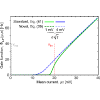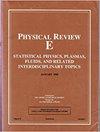尖峰神经元网络群体动力学的罗塞塔石碑
IF 2.4
3区 物理与天体物理
Q1 Mathematics
引用次数: 0
摘要
尖峰神经元模型的群体具有其微观变量(如单细胞膜电位)的密度,其演化完全捕捉了生物网络的集体动力学,甚至在平衡状态之外也是如此。尽管福克-普朗克方程具有普遍适用性,但对这种演化的研究主要还是在线性响应理论的范围内进行的,尽管其他频谱扩展方法在研究平衡外动力学方面具有一些优势。这主要是由于难以计算微分方程扩展系统中与状态相关的系数。在这里,我们通过将福克-普朗克方法的微扰解与谱扩展的对应解配对,推导出这些系数的解析表达式,从而解决了这一问题。其中几个系数与尖峰间隔密度的拉普拉斯变换(即首次通过时间的分布)之间存在紧密联系。电流-速率增益函数、福克-普朗克算子的特征值及其边界特征函数等 "系数 "的推导无需借助积分表达式。对于泄漏性积分-发射神经元,还计算出了静态和非静态模式之间的耦合项,为准确描述相互作用种群网络中的临界点和弛豫时标铺平了道路。本文章由计算机程序翻译,如有差异,请以英文原文为准。

Rosetta stone for the population dynamics of spiking neuron networks
Populations of spiking neuron models have densities of their microscopic variables (e.g., single-cell membrane potentials) whose evolution fully capture the collective dynamics of biological networks, even outside equilibrium. Despite its general applicability, the Fokker-Planck equation governing such evolution is mainly studied within the borders of the linear response theory, although alternative spectral expansion approaches offer some advantages in the study of the out-of-equilibrium dynamics. This is mainly due to the difficulty in computing the state-dependent coefficients of the expanded system of differential equations. Here, we address this issue by deriving analytic expressions for such coefficients by pairing perturbative solutions of the Fokker-Planck approach with their counterparts from the spectral expansion. A tight relationship emerges between several of these coefficients and the Laplace transform of the interspike interval density (i.e., the distribution of first-passage times). “Coefficients” like the current-to-rate gain function, the eigenvalues of the Fokker-Planck operator and its eigenfunctions at the boundaries are derived without resorting to integral expressions. For the leaky integrate-and-fire neurons, the coupling terms between stationary and nonstationary modes are also worked out paving the way to accurately characterize the critical points and the relaxation timescales in networks of interacting populations.
求助全文
通过发布文献求助,成功后即可免费获取论文全文。
去求助
来源期刊

Physical review. E
物理-物理:流体与等离子体
CiteScore
4.60
自引率
16.70%
发文量
0
审稿时长
3.3 months
期刊介绍:
Physical Review E (PRE), broad and interdisciplinary in scope, focuses on collective phenomena of many-body systems, with statistical physics and nonlinear dynamics as the central themes of the journal. Physical Review E publishes recent developments in biological and soft matter physics including granular materials, colloids, complex fluids, liquid crystals, and polymers. The journal covers fluid dynamics and plasma physics and includes sections on computational and interdisciplinary physics, for example, complex networks.
 求助内容:
求助内容: 应助结果提醒方式:
应助结果提醒方式:


